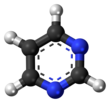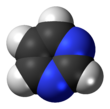Pyrimidine
| |||
| |||
| Names | |||
|---|---|---|---|
| Preferred IUPAC name
Pyrimidine[1] | |||
| Systematic IUPAC name
1,3-Diazabenzene | |||
| Other names
1,3-Diazine
m-Diazine | |||
| Identifiers | |||
3D model (
JSmol ) |
|||
| ChEBI | |||
| ChEMBL | |||
| ChemSpider | |||
ECHA InfoCard
|
100.005.479 | ||
| KEGG | |||
| MeSH | pyrimidine | ||
PubChem CID
|
|||
| UNII | |||
CompTox Dashboard (EPA)
|
|||
| |||
| |||
| Properties | |||
| C4H4N2 | |||
| Molar mass | 80.088 g mol−1 | ||
| Density | 1.016 g cm−3 | ||
| Melting point | 20 to 22 °C (68 to 72 °F; 293 to 295 K) | ||
| Boiling point | 123 to 124 °C (253 to 255 °F; 396 to 397 K) | ||
| Miscible (25°C) | |||
| Acidity (pKa) | 1.10[2] (protonated pyrimidine) | ||
Except where otherwise noted, data are given for materials in their standard state (at 25 °C [77 °F], 100 kPa).
| |||
Pyrimidine (C4H4N2;
In
(U).Occurrence and history

The pyrimidine ring system has wide occurrence in nature[5] as substituted and ring fused compounds and derivatives, including the
Nomenclature
The nomenclature of pyrimidines is straightforward. However, like other heterocyclics,
Physical properties
Physical properties are shown in the data box. A more extensive discussion, including spectra, can be found in Brown et al.[12]: 242–244
Chemical properties
Per the classification by Albert[13]: 56–62 six-membered heterocycles can be described as π-deficient. Substitution by electronegative groups or additional nitrogen atoms in the ring significantly increase the π-deficiency. These effects also decrease the basicity.[13]: 437–439
Like pyridines, in pyrimidines the π-electron density is decreased to an even greater extent. Therefore,
Electron
Reduction in
Pyrimidine is also found in
Synthesis
Pyrimidine biosynthesis creates derivatives —like orotate, thymine, cytosine, and uracil— de novo from carbamoyl phosphate and aspartate.
As is often the case with parent heterocyclic ring systems, the synthesis of pyrimidine is not that common and is usually performed by removing functional groups from derivatives. Primary syntheses in quantity involving formamide have been reported.[12]: 241–242
As a class, pyrimidines are typically synthesized by the principal synthesis involving cyclization of β-di
: 149–239Pyrimidines can be prepared via the
A novel method is by reaction of N-vinyl and N-aryl
Reactions
Because of the decreased basicity compared to pyridine, electrophilic substitution of pyrimidine is less facile. Protonation or alkylation typically takes place at only one of the ring nitrogen atoms. Mono-N-oxidation occurs by reaction with peracids.[4]: 253–254
Free radical attack has been observed for pyrimidine and photochemical reactions have been observed for substituted pyrimidines.[12]: 15–16 Pyrimidine can be hydrogenated to give tetrahydropyrimidine.[12]: 17
Derivatives
| Formula | Name | Structure | C2 | C4 | C5 | C6 |
|---|---|---|---|---|---|---|
| C4H5N3O | cytosine |  |
=O | –NH2 | –H | –H |
| C4H4N2O2 | uracil | =O | =O | –H | –H | |
| C4H3FN2O2 | fluorouracil | =O | =O | –F | –H | |
| C5H6N2O2 | thymine | =O | =O | –CH3 | –H | |
| C4H4N2O3 | barbituric acid | =O | =O | –H | =O | |
| C5H4N2O4 | orotic acid | =O | =O | –H | -COOH |
Nucleotides

Three nucleobases found in nucleic acids, cytosine (C), thymine (T), and uracil (U), are pyrimidine derivatives:

Chemical structure of cytosine 
Chemical structure of thymine 
Chemical structure of uracil Cytosine (C)Thymine (T)Uracil (U)
In
(G) pair up with the pyrimidines thymine (T) and cytosine (C), respectively.In RNA, the complement of adenine (A) is uracil (U) instead of thymine (T), so the pairs that form are adenine:uracil and guanine:cytosine.
Very rarely, thymine can appear in RNA, or uracil in DNA, but when the other three major pyrimidine bases are represented, some minor pyrimidine bases can also occur in
These hydrogen bonding modes are for classical Watson–Crick base pairing. Other hydrogen bonding modes ("wobble pairings") are available in both DNA and RNA, although the additional 2′-hydroxyl group of RNA expands the configurations, through which RNA can form hydrogen bonds.[22]
Theoretical aspects
In March 2015,
Prebiotic synthesis of pyrimidine nucleotides
In order to understand how life arose, knowledge is required of the chemical pathways that permit formation of the key building blocks of life under plausible prebiotic conditions. The RNA world hypothesis holds that in the primordial soup there existed free-floating ribonucleotides, the fundamental molecules that combine in series to form RNA. Complex molecules such as RNA must have emerged from relatively small molecules whose reactivity was governed by physico-chemical processes. RNA is composed of pyrimidine and purine nucleotides, both of which are necessary for reliable information transfer, and thus natural selection and Darwinian evolution. Becker et al. showed how pyrimidine nucleosides can be synthesized from small molecules and ribose, driven solely by wet-dry cycles.[26] Purine nucleosides can be synthesized by a similar pathway. 5’-mono-and diphosphates also form selectively from phosphate-containing minerals, allowing concurrent formation of polyribonucleotides with both the pyrimidine and purine bases. Thus a reaction network towards the pyrimidine and purine RNA building blocks can be established starting from simple atmospheric or volcanic molecules.
See also
References
- ISBN 978-0-85404-182-4.
- ^ Brown, H. C.; et al. (1955). Baude, E. A.; F. C., Nachod (eds.). Determination of Organic Structures by Physical Methods. New York, NY: Academic Press.
- ISBN 978-0-582-27843-1.
- ^ ISBN 978-1-405-13300-5.
- ^ S2CID 9942715.
- ^ Grimaux, E. (1879). "Synthèse des dérivés uriques de la série de l'alloxane" [Synthesis of urea derivatives of the alloxan series]. Comptes Rendus Hebdomadaires des Séances de l'Académie des Sciences. 88: 85–87.

- ^ Kenner, G. W.; Todd, Alexander (1957). Elderfield, R.C. (ed.). Heterocyclic Compounds. Vol. 6. New York: Wiley. p. 235.
- .
- ^ ISBN 978-0-471-50656-0.
- ^ a b Albert, Adrien (1968). Heterocyclic Chemistry, an Introduction. London: Athlone Press.
- ; Collected Volumes, vol. 4, p. 182.
- ; Collected Volumes, vol. 4, p. 336.
- PMID 19778279.
- S2CID 253219218.
- ; Collected Volumes, vol. 4, p. 638.
- ; Collected Volumes, vol. 5, p. 794.
- PMID 17076488.
- ISBN 978-1429208925.
- S2CID 238840705.
- ^ Marlaire, Ruth (3 March 2015). "NASA Ames reproduces the building blocks of life in laboratory" (Press release). NASA. Retrieved 5 March 2015.
- PMID 24512484.
- ), also published as Barbatti, M.; Borin, A. C.; Ullrich, S. (eds.). "14: Photosynthesis and photo-stability of nucleic acids in prebiotic extraterrestrial environments". Photoinduced phenomena in nucleic acids. Berlin, Heidelberg: Springer-Verlag. p. 499.
- ^ Becker S, Feldmann J, Wiedemann S, Okamura H, Schneider C, Iwan K, Crisp A, Rossa M, Amatov T, Carell T. Unified prebiotically plausible synthesis of pyrimidine and purine RNA ribonucleotides. Science. 2019 Oct 4;366(6461):76-82. doi: 10.1126/science.aax2747. PMID 31604305








